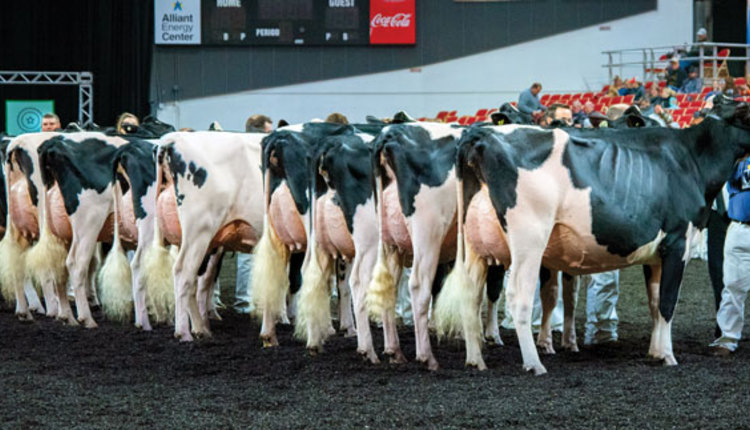The author is with the School of Veterinary Medicine, University of Wisconsin.
I am working with a 600-cow dairy that is experiencing a unique pneumonia-like situation. The dairy is very well managed.
When the symptoms appear, they are across all lactating cows, are random and begin approximately two weeks into lactation. The first clinical signs are being off-feed and "virus-like" symptoms. Milk drops to 10 percent of regular production and, if left undetected, it does not recover. No animals have died.
P.D., Ontario, Canada
Early lactation is a time of high stress, reduced immunity and metabolic challenges for calving cows. Group and feed changes, exposure to new animals, social adjustments, pathogen challenges and acclimation to the milking routine make that time a high-risk period.
Under these circumstances, it is not unexpected that subclinical and clinical conditions occur. These can include milk fever, ketosis, retained placenta, metritis, diarrhea, pneumonia, displaced abomasum and fever of unknown origin.
You have provided limited information on the clinical signs seen in the affected cows, but we presume that your reference to "virus-like" signs is an indication that cows have a high fever. High fever with pneumonia-like signs in fresh cows, although by no means specific, makes us worry about Salmonella Dublin, bovine respiratory syncytial virus (BRSV) or bovine viral diarrhea virus (BVDV) infections.
The drastic reduction in milk yield that you are seeing along with the possibility of additional economic consequences from the three diseases mentioned make it extremely important that you involve your veterinarian in troubleshooting.
Heavy breathing in cattle with high fevers may not be pneumonia. High rectal temperatures in cows aren't always a fever. Your veterinarian, who knows your herd and its vaccination history, will do a complete physical examination and know which diagnostic tests are most suitable to clarify whether this problem is viral, bacterial or something else.
Vaccination status, not just for the well-managed cows on the farm but for all other contact cattle, is very important. Of special importance are the first-calf heifers that may be returning to the farm from a remote site. We know of herds where the source of a problem like yours was the lapsed vaccination status of incoming first-lactation cows. We encourage you to aggressively pursue a cause of the fresh cow fevers.
Until a diagnosis is made, have every affected cow examined, continue to use recommended diagnostic tools and, should there be a death, have a fresh postmortem examination be performed.
Click here to return to the Animal Care E-Sources
1212_834
I am working with a 600-cow dairy that is experiencing a unique pneumonia-like situation. The dairy is very well managed.
When the symptoms appear, they are across all lactating cows, are random and begin approximately two weeks into lactation. The first clinical signs are being off-feed and "virus-like" symptoms. Milk drops to 10 percent of regular production and, if left undetected, it does not recover. No animals have died.
P.D., Ontario, Canada
Early lactation is a time of high stress, reduced immunity and metabolic challenges for calving cows. Group and feed changes, exposure to new animals, social adjustments, pathogen challenges and acclimation to the milking routine make that time a high-risk period.
Under these circumstances, it is not unexpected that subclinical and clinical conditions occur. These can include milk fever, ketosis, retained placenta, metritis, diarrhea, pneumonia, displaced abomasum and fever of unknown origin.
You have provided limited information on the clinical signs seen in the affected cows, but we presume that your reference to "virus-like" signs is an indication that cows have a high fever. High fever with pneumonia-like signs in fresh cows, although by no means specific, makes us worry about Salmonella Dublin, bovine respiratory syncytial virus (BRSV) or bovine viral diarrhea virus (BVDV) infections.
The drastic reduction in milk yield that you are seeing along with the possibility of additional economic consequences from the three diseases mentioned make it extremely important that you involve your veterinarian in troubleshooting.
Heavy breathing in cattle with high fevers may not be pneumonia. High rectal temperatures in cows aren't always a fever. Your veterinarian, who knows your herd and its vaccination history, will do a complete physical examination and know which diagnostic tests are most suitable to clarify whether this problem is viral, bacterial or something else.
Vaccination status, not just for the well-managed cows on the farm but for all other contact cattle, is very important. Of special importance are the first-calf heifers that may be returning to the farm from a remote site. We know of herds where the source of a problem like yours was the lapsed vaccination status of incoming first-lactation cows. We encourage you to aggressively pursue a cause of the fresh cow fevers.
Until a diagnosis is made, have every affected cow examined, continue to use recommended diagnostic tools and, should there be a death, have a fresh postmortem examination be performed.
1212_834









